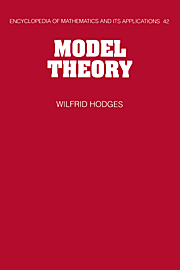Book contents
- Frontmatter
- Contents
- Introduction
- Note on notation
- 1 Naming of parts
- 2 Classifying structures
- 3 Structures that look alike
- 4 Automorphisms
- 5 Interpretations
- 6 The first-order case: compactness
- 7 The countable case
- 8 The existential case
- 9 The Horn case: products
- 10 Saturation
- 11 Combinatorics
- 12 Expansions and categoricity
- Appendix: Examples
- References
- Index to symbols
- Index
3 - Structures that look alike
Published online by Cambridge University Press: 08 October 2009
- Frontmatter
- Contents
- Introduction
- Note on notation
- 1 Naming of parts
- 2 Classifying structures
- 3 Structures that look alike
- 4 Automorphisms
- 5 Interpretations
- 6 The first-order case: compactness
- 7 The countable case
- 8 The existential case
- 9 The Horn case: products
- 10 Saturation
- 11 Combinatorics
- 12 Expansions and categoricity
- Appendix: Examples
- References
- Index to symbols
- Index
Summary
M Martin: J'ai une petite fille, ma petite fille, elle habite avec moi, chère Madame. Elle a deux ans, elle est blonde, elle a un oeil blanc et un oeil rouge, elle est très jolie, elle s'appelle Alice, chère Madame.
Mme Martin: Quelle bizarre coïncidence! moi aussi j'ai une petite fille, elle a deux ans, un oeil blanc et un oeil rouge, elle est très jolie et s'appelle Alice, cher Monsieur!
M Martin, même voix traînante, monotone: Comme c'est curieux et quelle coïncidence!
Eugène Ionesco, La cantatrice chauve, © Editions GALLIMARD 1954.If we consider a first-order language L, the number of isomorphism types of L-structures is vastly greater than the number of theories in L (counted up to equivalence of theories). So there must be some huge family of non-isomorphic L-structures which it is impossible to tell apart by sentences of L.
In this chapter we prove a variety of theorems which have the general form: if some sentence is true here, then it must be true there too.
Theorems of Skolem
In earlier days there were people who disliked uncountable structures and wanted to show that they are unnecessary for mathematics. Thoralf Skolem was one such. He proved that for every infinite structure B of countable signature there is a countable substructure of B which is elementarily equivalent to B. He inferred from this that there are countable models of Zermelo–Fraenkel set theory, and hence countable models of the sentence ‘There are uncountably many reals’.
Information
- Type
- Chapter
- Information
- Model Theory , pp. 87 - 130Publisher: Cambridge University PressPrint publication year: 1993
